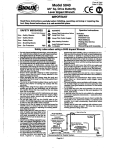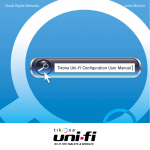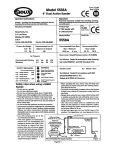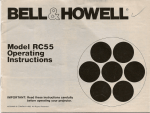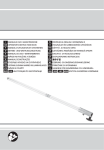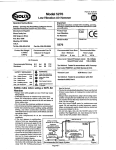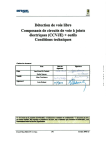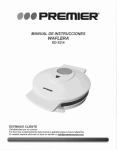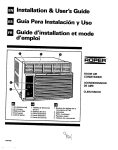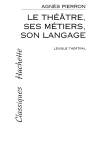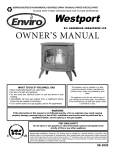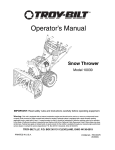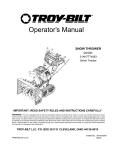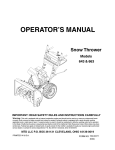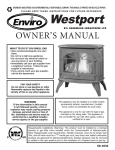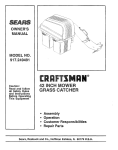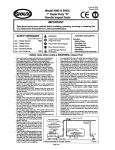Download Sioux Tools 5038B User's Manual
Transcript
Operator Instructions
Important
Includes - Foreseen Use, Work Stations, Putting Into Service,
Operating, Dismantling,Assembly and Safety Ruies.
Read these instructions carefully before installing, operating,
servicing or repairingthis tool. Keep these instructionsin a safe
accessible (dace.
Product Type
3/8" Square Drive Pistol
Grip Impact Wrenches
Sioux Tools, Inc.
117 Wi Drive
1
Murphy, NC 28906
U.S.A.
Tel No. 828-835-9765
-
-
50388 Steel Nose Case
Chrome Plated
5039B Steel Nose Case
Fax No. 828-835-9685
Black
- -
RecommendedH o s e Bore
Size - Minimum
318ins
10mm
Recommended Use Of
Balancer Or Support
NO
Product Net Weight
3.75 Ibs
1.70 Kg
Recommendedworking
Maximum
---
SAFETY MESSAGES
Personal Safety Equipment
Use-S&tyGIase~
Use Safety Gloves
YES
-
Use - Safety Boots
Use - BreathingMasks
USB- Ear Pme3oss
6.2
6.2
IA
1
@
YES
A
Recommended Max.
Hose Length
30 Ft
10 M
Noise Level: Sound Pressure Level 84.6 dB(A)
Sound Power Level
95.6 dB{A)
Air Pressure
-
Serial No.
Model No/Nos
bar
bar
90
90
PSI
PSI
Test Method: Tested in accordance with Pneurop
test code PN8KTC1 and IS0 Standard 3744
WARNING
Vibration Level
Always Wear Safety
Test Method: Tested in accordance with IS0
standards 8662 Parts 1 & 7
3.5
Meters 1 Sec2
Wegr Hearing Protection
Avoid Prolonged Exposure
Safety rules when using 50380 and
5039B Impact Wrenches
the body and particularly the hands away from the
working attachment fixed to the toot.
-The tool is n'ot electrically insulated. Never use the tool
if there is any chance of corning into contact with live
electricity.
- Always when using the too!, adopt a firm footing andfor
position and grip the tool sufficiently only to overcome
any reaction forces that may result from the tool doing
work. Do not overgrip.
-Use only correct spare parts for maintenance and
repair. Do not improvise or make temporary repairs.
Major servicing and repairs should only be carried out
by persons trained to do so.
-Do not lock, tape, wire. etc. the 'OnIOff' valve in 'On'
position. The triggernever, etc. must always be free to
- U s e only impact sockets and extensions, universal
joints, etc. rated as being suitable for use with impact
wrenches.
-Prolonged exposure to vibration may cause injury.
-Read all instructions before using this tool. AH
operators must be fully trained in its use and aware of
these safety rules.
- Do not exceed the maximum working air pressure.
- Use personal protection equipment as recommended.
- Some dust created by power sanding, sawing, grinding,
drilling, and other construction activities contains
chemicals known to cause cancer, birth defects and other
reproductive harm.
- U s e only compressed air a? the ,
recommended conditions.
1
A* Pipe And Finings
- I f the tool appears to malfunction,
Stwufd Se Iff"
0 Larger
remove from use immediately and
Compressor
arrange for service and repair. If it is
with Sufficient Capacity
not practical to remove tool from
To Maintain Recommended
Workig Pressure Ai
service, then shut off the air supply
to the tool and write or have written a
warning note and attach it to the tool.
- If toot is to be used with a balancer or
other suspension device, ensure that
the tool is firmly attached lo the
suspension/support device.
-When operatinittietool. always keep
RecommendedAir Supply System
1
Page No 1
Take Air From Top
Low Spot To
Figure 1
return to the 'Off' position when released.
-Always shut off the air supply to the tool and press the
'OntOff' valve to exhaust the air from the feed hose
before fitting, removing or adjusting the working
attachment fitted to the tool.
-Before using the tool, make sure that a shut off device
has been fitted to the air supply line and the position is
known and easily accessible so that the air supply to
the tool can be shut off in an emergency.
-Check hose and fittings regularly for wear-Take care against entanglement of the moving parts
of the tool with clothing, hair, ties, cleaning rags, rings,
jewelry, watches, bracelets, etc. This could cause the
body or parts of the body to be drawn towards and in
contact with the moving parts of the tool and could be
very dangerous.
- I t is expected that users will adopt safe working
practices and observe all local, regional and country
legal r e q u i r e m e n t s when installing, using or
maintaining the tool.
-Take care that the exhaust air does not point towards
any other person or material or substance that could
be contaminated by oil droplets. When first lubricating
a tool or if the tool exhaust has a high oil content, do
not allow the exhaust air to come near very hot
surfaces or flames.
N e v e r lay the tool down until the working attachment
Work Stations
-
Putting Into Service
Air Supply
has stopped moving.
-When the tool is no?in use, shut off the air supply and
press the triggerflever to drain the supply line. If the
toot is not to be used for a period of time, first
lubricate,
disconnect from air supply and store in a dry average
room temperature environment.
- I f the tool is passed from one user to a new or
inexperienced user, make sure these instructions are
passed with the tool.
- Do not remove any manufacturer fitted safety devices
where fitted, i.e., wheel guards, safety trigger, speed
governors, etc.
-Wherever possible, secure workplace with clamps, a
vise, etc. to make it rigid so it does not move during
the work operation. Keep good balance at all times.
Do not stretch or overreach.
-Try to match the too! to the work operation. Do not use
a tool that is too light or heavy for the work operation.
If in doubt, seek advice.
- i n general terms, this too! is not suitable for
underwater use or use in explosive environments seek advice from manufacturer.
-Try to make sure that the work area is dear to enable
the work task to be performed safely. If practical and
possible, try to clear unnecessary obstructions before
starting work.
-Always use air hose and couplings with minimum
working pressure ratings at least 1 112 times the
maximum working pressure rating of the tool.
-
- 5038Bl
The impact wrench is designed for the tightening and loosening of
threaded fasteners within the range as specified by the
manufacturer It should only be used 10 conjunction with suitable
impact type 318' square female drive nut running sockets. Only
use sockets which are of the impact type.
It is allowed to use suitable extension bars. univefsat joints and
socket adaptors between the square output drive of the impact
wrench and the square female drive oi the socket.
Do not use the tool for any other purpose than that specified
without consulting the manufacturer or the manufacturer's
authorized supplier To do so may tie dangerous,
Never use an impac! wrewhas a hammer to dislodge or straighten
cross threaded fasteners. Never attempt to modify the tool fw other
uses and never modify the too) for even its recommendeduse as a
nutrunner
Use a clean lubricated air supply that will give a measured air
pressure at the tool of 90 p.s.i.16.2 tsar when the tool is running
with the trigger fully depressed and the air regulator i n its
maximum opening flow position. Use recommeridedhose size and
length. 1; is recommended that the tool is connected to the air
supply as shown in figure 1. Do not connect a quick connect
coupling directly to the 8001, but use a whip or leader hose of
approximtely 12 inches length. Do not connect the tool to the air
line system without incorporating an easy to reach and operate air
shut off valve. The air supply should be lubricated. It is strongly
recommended that an air filter, regulator, lubricator (FRL) is used,
as shown in Figure 1, as this will supply clean, lubricated airat the
correct pressure to the tool. Details of such equipment can be
obtained from your supplier. If such equipment is not used. then
the tool should be lubricated by shutting off the air supply 40 the
tool, depressurizing the line by pressing the ihronle lever on the
too). Disconnect the air line and pour into the hose adaptor (9) a
teaspoonful (5ml) of a suitable pneumatic motor lubricating oil
preferably incorporating a rust inhibitor. Reconnect tool to air
supply and run tool slowly for a few seconds to allow air to
circulate the oil. If tool is used frequently, lubricate on daily basis
and if tool starts to slow or lose power. When lubricating, also
ensure that the air strainer in hose adaptor (9) is clean.
It is recommended that joint tightness of the threaded fastener
assembly be checked with suitabie measuring equipment.
It is recommendedthat the air pressure a! the tool while the tool is
running is 90 p.s.i./6.2 bar.
Operating
The output of the impact wench in prime working condition is
governed by mainly three factors:
a) the input air pressure;
b) the time the impact wrench is operated on the joint. Normal time
for joints of average tension requirement 3 to 5 seconds;
c) the selling of the air regulator for a given joint at a given pressure
operated for a given time.
The air regulator (26) can be used to regulate the output of the
impact wench if no other means of control is available. It is strongly
r m m d e d that an external pressure regulator, ideally as part of
-
Foreseen Use Of The Tool
50396
The tool should only be used as a handheld, hand operated tool. It
is always recommendedthat the tool is used when standing on the
solid floor. It can be used in other positions. but before any such
use, the operator must be in a secure position having a firm grip
and footing and be aware that when loosening fasteners the tool
can move quite quickty away from the fastener being undone. An
allowance must always be made for this rearwardmovement so as
to avoid the oossibilitv of hand/arm/bodv entrapment.
a filter/rqulator/ltibricator (FRL). is usedto control air inlet pressure
so that the pressure can be set to help control the tension required
to he applied to Ihe threaded fastener joint
There is no consistent. reliable torque adjustment on an impact
wrench of this type. However, the air regulatorcan be used to adjust
torque to theapproximatetightnessof a known threadedjoint.Toset
the toolto the desired torque, select a nut or screw of known
tightness of the same size, thread pitchand thread conditionas those
on (tie job.Turn air regulator to low position,apply wrench $0nut and
gradually increase power (turn regulator to admit more air) until nut
moves slightly if!the direction it was originally set.The tool is now set
to duplicatethattigMness, note regulatorsettingfor future use.When
tightening nuts not requiring critical torque values, run nut up Hush
and then tighten an additional one-quarter to one-half turn (sBght
additfonal turning is necessary if gaskets are being damped). For
additional power needed on disassembly work, turn regulator to its
fully open position. This impact wrencti is rated a 3/8" bolt size.
Rating must be downgraded far spring U bolts, tie bolts, long cap
screws, double depth nuts, badly rusted conditions and spring
fastenersas they absorb much of the impact power. When possible,
clamp or wedge the bolt to prevent springback.
Soak rusted nuts in penetrating oil and break rust seal before
removing with impact wrench. tf mt does rat start to move in three to
five seconds use a larger size impact wrench. Do not use impact
wrench beyond rated capacity as this will drastically reduce tool life.
NOTE: Actual torque on a fastener is directly related to joint
hardness, tool speed, condition of socket and the time me tool is
allowed to impact.
Page No 2
parts with a suitablepneumatict w l lybricalinfl Oil anC!asseffif&lein
the reverse order. On completing assembly, emure that all pans
are locked tight, the anvil will rotate, and the trigger r
e vatve
and air regulate mechanism operate freeiy. Reiftow oil plug (2)
and pour is38 fl. oz.{iZcc) of a standard SASM) gradti oit. Do not
(werfia as this wit! wstjK in a iedu&r> in p e t t o r a n e e . Pour in
awm.5 mi oi a good quafay fubfiaaiq 04 <owprefefSSiy
contaiaiRg a mi ittht&ttor)istotfte (rose a&#tw (9) with the
aitgswdepressed.Confleciloaswtabfe&staspiyawlruniheto<a
foi a few secortds ta a8aw I h e oiS to cirwhls and reset fof
operaikiS.Refer K; s e e m Operating.
3) AteaysyseStS~owectsiii&Si^acttypesocket
2) Use extra (Seep aocfceES in piSCft 03 exiewfoti bars where
lÈs$ibte
3) &onotusewss^Kf.wornwaaticeasocteis.
As; CQft~ymc&M
4) MofetBwwrenchsotiieSOCK(Mfitssquara-iyon!hefastener.Hofsf
the wrench S r w ! ~bat not too tightty,ptesskig forward sSigitB^
lifaMmumT o w Reverse
Dismantiing Sc Assembly Instructions
MaximumTorque Forward
WortangToque Reverse
Disconnect toot iwm air supply.
Take out oil plug (2) swd ttcaxi ttw (ttt wntaioed in the fron eeoct of
the toot into a suitable corrtainer. Grip motor housing (1) in a vise
fitted with soft jaws and unscrew 4 screws with washers (33) and
pull off housing (46) as fitted and ramova O-ring (45).Oil seat (47)
may be hooked out of arri awil bushing (44) pressed out of
housing (46). Remove anvil Spacer (41). PuH off the hammer
mechanism completely awl pull it apart to separate anvil (40) or
(49). spring (39).2 hammer pins (37),hammer cam (381,cam ball
(36).cam ball pilot (35)and hammer cage (34). Socket ring (43)
and 0 ' r i i ' ~(4S) may b pried off awil(40) but do not try to remove
assembly iterris (SO) (coif) anvil (49).
Remove 4 screws with washers (33) ana carefully pull off end cap
(28) and gas-fet (29) completewith air regulator assembly. Remove
C-ring (30)and regulator swefMAy may be pullet) through end cap
(28)being careful not to tose spring (31) and steel ball (32)
Remove O-ring (27) ffotti air regulator reverse (26). Note in
particular the orientationof the parts to each other for reassembly.
Unscrew how adaptor {&) and take off exhaust dettector <8).Pull
out rear end plate (24) frith bait beating (25). TOW
(22). cylinder
{20). guide pin (23)and G row blades <£?
from motorhousing (1).
Tap out fromendpiate (19) completewithO+nog(13), oil sea){I?)
and bat! tearing ($6)
from Iwysing {f). Bat1 bearing <2S) may be
lapped out ofrear and plate (24) and oil $M
<1?)
I arrf &&I
beating
(IS)retrieved!mton! pMe{?9}.fiemove2$(yews(iS)atçicare
fuBywSsiosx!fpttSwttrigawass~hemhOTisung{I).The
Uiggaassail(naybasepwatediWparts.iriggerpaifKLstop
mwi-US), ¥ { h wbtisttitjg
ai
O-fifOS (11) an3 E-r&j (3). Nste
the SoeaBsn arri onentaaw of aii pass (w fsas?w*3y.
WorkingTorque Forward
~ iInlet
r ?l'arsatf
Overall Length
I
3.5 cte> (25ach)
1 2 i O tt. !bs. (285 ?0)
1 S 1 8 5 W .(08-251 Nm}
W i t i b s . pi51 Mm)
I 50-160ft.IteS.(68-217Nm)
I \ " W~SMPT
1
6.25- (159 mm)
f(.
-,----
at 90 PSIW6.2 bar
<*,
Reassembly
Ctean aii parts and waroKia iw wear arwi cracte. eit;. and repiacs
as necessary. Loot; inpartkoiar fa: wear antf curs oo 0-tiwjs and
seais awl w a r on row bia<tes.Lot* for waat and cracks on piam
of th@ hammer mscfiacAsm paqicotarty in Ihs area ofthe square
drive an arwils'(40) or (49). RspIace all parts a r e necessary
with manufacturer or authorial distribmor supplied parts. Make
sure that.the faces of end plates (19) and {24}That abut cylinder
(20)are itat and free ifom surface detectsanti bum. Ifnecessary.
lap faces with a vary twin. grade of abrasive paper. Ugh* coat aH
Declaration of Conformity
"N
Sioux Tools, Inc.
117 Levi Drive, Murphy, NC 28906, U.S.A.
declare under our sole responsibSty that the product
Model 5038Bl5039B Impact Wrenches, Serial Number
to which this declaration relates is in conformity with the following standard($) of other normative docurnent(s)
EN792 (Draft), EN292 Parts 1 & 2, IS0 8662 Parts 1 & 7, Pneurop PN8NTC1
891392EEC as amended by 91/368/EEC& 93144EEC Directives
foliowing the provisions of
@t
G a
A-
.Seebeck (President)
Primed in Japan
Page No 3
Modele 5038Bl5039B
S r i e "B"
Cles a chocs a poignk pistolet avec carre
conducteur de 3/8 po (93 mm)
Instructions de fonctionnement
Important
-
~
Comprend : Utilisation pf<'vue, stations de travail, mise en
service, fonctionnement, demontage, montage et rfrgles de
Usez attentivement ces instructions avant d'installer.
7
Fype de produit
Cles $chocs
i
poigmk
pistolet avec carre
Sioux Tools, Inc.
Poids net du produit
1,70 kg
*
de faire
fonctinnner.
d'entretmir
M
- - - - - -- ---- (
-I de knaref cet outil- Gardez ces
instmctlonsdans un endroit & et f a c h e n t accessible.
s6curit6,
117 Levi Drive
Murphy, NC 28906
U.S.A.
Tel No. 828-835-9765
ce
3.m
ttmin
~onducteurde 3/8PO
Fax No. 828-835-9685
Emploi conseille d'un
diisposftif d'6quilibrage ou
d'un support.
NON
10 mrn
10 rn
Niveau sonore:
Pression #air
Niveau de pression sonore 84,6 dB(A)
Niveau de puissance sonore 95,6 dB(A)
De fonctionnement
recommandee
6,2 bar
Maximum
6,2 bar
Methode de test Test4 selon Ie code de test
Pneurop PN8fn"Cl et la nonne IS0 3744.
Niveau de vibrations
3,5 rn/s2
Methode detest: test&seton les norrnes I S 0
8662, sections 1 & 7
Quand vous employez I'outil,tenez toujours Ie corps et les
mains a 1'ecart des accessoires de travail fixes a I'outil.
Cet outil n'est pas isde 6lectriquemenL N'employez
jamis cet outil si vous risque2d'entrer en contact avec de
Regles de securite pour I'emploi des
cles a chocs 5038B/5039B
Employez seulement des dauilles, rallonges, cardans,
etc. pour de a choc qui respondent aux conditions
nominales de ionctionnement de la cl4 a chocs.
Une exposition prolongbeaux vibrations pent causer des
blessures.
Lisez les instructions avant d'employer cet outil. Tous Ie
~Derateursdoivent connaitre ~artaiternenlson utitisation
ei connartre ces rdgles de s&rite.
Ne depassez pas la pression d'air de foncfionnement
maximum.
Employez r6quipement de protection pereonnelle
recornman&.
Certaines poussiferes engendrees par le pondage, Ie
sciage, Ie meulage, le pereage pneumatique et d'autres
activites de construction contiennent des produits
chimiques qui sont connus cornme ,.
provoquant ie cancer, des anomalies
conaenitales et d'autres troubles
relectridte.
-
Quand vous employezcet outil, prenez une position ferrne
et tenez Men I'outit pour compenser toutes forces de
reactionqui pourraient etre caudes par Iefonctionnement
de I'outit. Ne sen-ez pas trop fort dans les mains.
Employez seulement des pieces de rechange correctes
pour rentretien et les reparations. N'irnprovisez pas de
rkparations temporaires. L'enlretien et !es reparationsne
d o i t etre eifectuees que par du personnel quafifie.
Ne btoquez pas les valves "OdOff en position dans la
position "On" (en service). Le levier de commando doit
toujows etre libre de retournerdans la position "Off (hors
service) wand on Ie relache.
Arretez toujours I'arfivee $air & I'outil et appuyez sur 4a
son aire de service,d t e z Fairiv& (fair et
fixez une note (favertissement manuscrite
ar a .
Si i'oulil doit ktre employ& avec un
dispositifrf^quiftorageoude suspension,
assurez-vousque I'ouW est bien fix4 ace
systhe de suspension ou de support.
Svsterne (fatimentation &air recommande
Page No 4
Fiaure 1




















